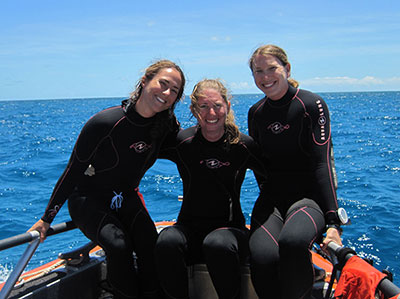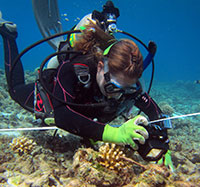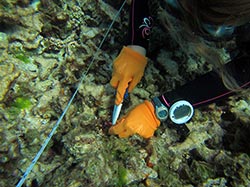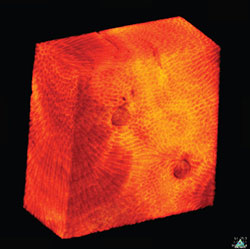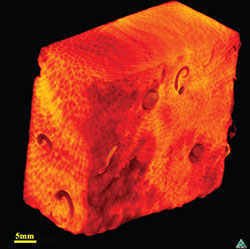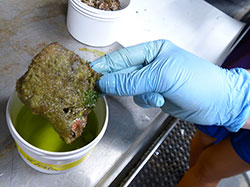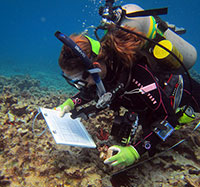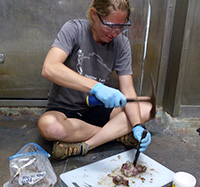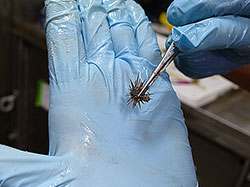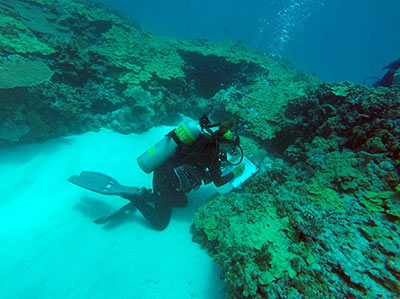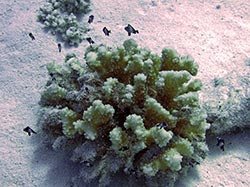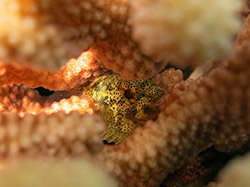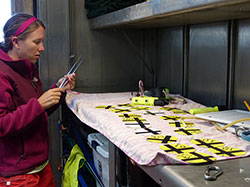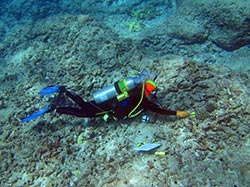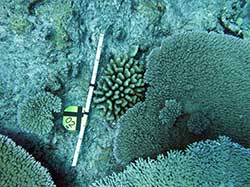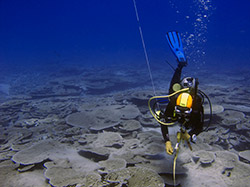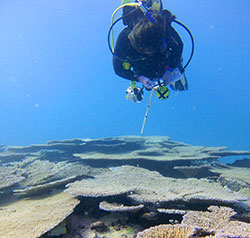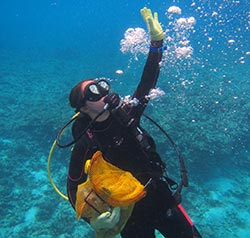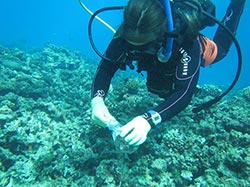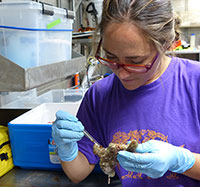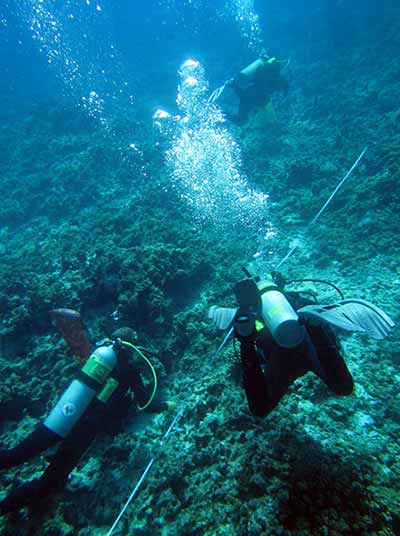RAMP | August 23, 2014: Team ‘Pomerosion’ |
| by guest blogger Emily Gaskin, 2014 RAMP Data Manager |
The RAMP expeditions encourage innovative specialists who conduct forward-thinking research to address some of the most critical threats to our oceans, and the scientists from the Hawaiʻi Institute of Marine Biology (HIMB) are no exception. ‘Team Pomerosion’ (a combination of two different projects that focus on the cauliflower coral Pocillopora meandrina and bioerosion), is made up of Nyssa Silbiger, Chelsie Counsell and Eileen Nalley. They are looking at changes in coral communities over time and across locations to inform management and planning in the Hawaiian Archipelago.
Bioerosion Project
Nyssa Silbiger, Ph.D. Candidate at the Hawaiʻi Institute of Marine Biology and a Nancy Foster Scholar, has been conducting research in the Northwestern Hawaiian Islands since 2009. Her research on bioerosion looks at how worms, sponges and bivalves that live within the cracks and crevices of the reef break down dead coral skeleton into sand.
After leaving calcium carbonate blocks on the seafloor for a period of time, Nyssa collects them and sends them off for a micro CTscan at Cornell University, just like the CTscan you would get at the hospital (with a resolution that can note erosion scars as thin as a piece of hair!). The scans tell her how much of the block has eroded over time.
See video animation of CT scan progression here.
Nyssa also collects dead coral rubble samples and, with a donated blender from BlendTech ®, grinds the rubble into a slurry and extracts DNA to determine the makeup of bioeroder communities. She does this in both the main and Northwestern Hawaiian Islands and compares the results.
By better understanding these bioeroder communities, and how they vary across the archipelago, she is able to address critical management questions, such as how climate change is shifting the balance from net coral growth to net reef erosion. Climate impacts, such as ocean acidification, are slowing coral growth and increasing bioerosion.
Efforts to address key climate drivers are critical but may not be feasible in the short term. In the meantime, Nyssa believes that local management to reduce other human-induced stressors like pollution and fishing may help increase the resiliency of coral reefs in Hawaiʻi. She feels that education about the marine environment is critical to fostering conscientious ocean stewards.
Through the Nancy Foster Scholarship, which is funded by the Office of National Marine Sanctuaries to support high quality applied student research in our sanctuaries, Nyssa is an ambassador for our national underwater treasures.
Onboard, Nyssa dominates the ping pong table and enjoys the odd game of cribbage. When she isn’t sailing the high seas, Nyssa can often be found riding a wave or climbing a mountain.
Pocillopora Cryptofauna
Chelsie Counsell, a Graduate Student Researcher at the Hawaiʻi Institute of Marine Biology and National Science Foundation Graduate Research Fellow, is joining the RAMP expedition for the first time. Her research looks at semi-cryptic fish and invertebrate communities (critters that hide) in Pocillopora (cauliflower) corals. She is interested in how these organisms vary across different conditions, such as reef depth and size of the coral colony.
Until now, Chelsie has only studied Pocillopora coral communities in the main Hawaiian Islands, but the opportunity to research coral communities in the Northwestern Hawaiian Islands will allow her to compare these communities, identify varying threats, and assess connectivity between islands. She notes that the community differences between sites can be quite dramatic, for example damselfish and scorpionfish appear to be entirely absent in some locations and then present on every other coral at other sites. She is excited to analyze the survey data being collected on this cruise to see how these differences pan out between sites around each atoll, between atolls, and between the Northwestern Hawaiian Islands and the main Hawaiian Islands.
In addition to looking at the differences in biodiversity, Chelsie’s research may reveal details on connectivity between the semi-cryptic reef species in the main Hawaiian Islands and the Northwestern Hawaiian Islands. Whenever dive time and surge conditions allow, team Pomerosion has been collecting fin clips from small scorpionfish species that live within the corals. Using genetics, these tissue samples will help her understand connectivity patterns in these scorpionfish around atolls and at larger spatial scales. This work will contribute to establishing a baseline of these semi-cryptic critters in the NWHI.
When Chelsie is not at sea she likes to train for triathlons, play the ukulele, mountain bike with her husband, and hike with her dogs. Rumor has it she also has a secret recipe for the world’s best lemon cupcakes with raspberry frosting (surprise: they’re vegan!).
Student Support
Eileen Nalley is a rising second year Ph.D. student in Marine Biology who joined the RAMP expedition for the first time to assist Nyssa and Chelsie with their research projects. Her primary responsibilities include collecting dead coral rubble for bioerosion testing, and photographing Pocillopora corals to measure coral size.
Eileen is grateful for the opportunity to work in the Northwestern Hawaiian Islands and hopes to return in the future to conduct her own research project.
In her free time, Eileen enjoys riding her bike all over O‘ahu and exploring the reef at her neighborhood beach. Having mastered the art of growing the perfect tomato in Hawaiʻi, she is now moving on to more challenging tasks including baking the ideal granola bar and brewing chipotle beer.
Team Pomerosion will continue their work on bioerosion and Pocillopora coral communities at RAMP’s next stop, Lisianski Island.
Return to RAMP Expedition Log.
